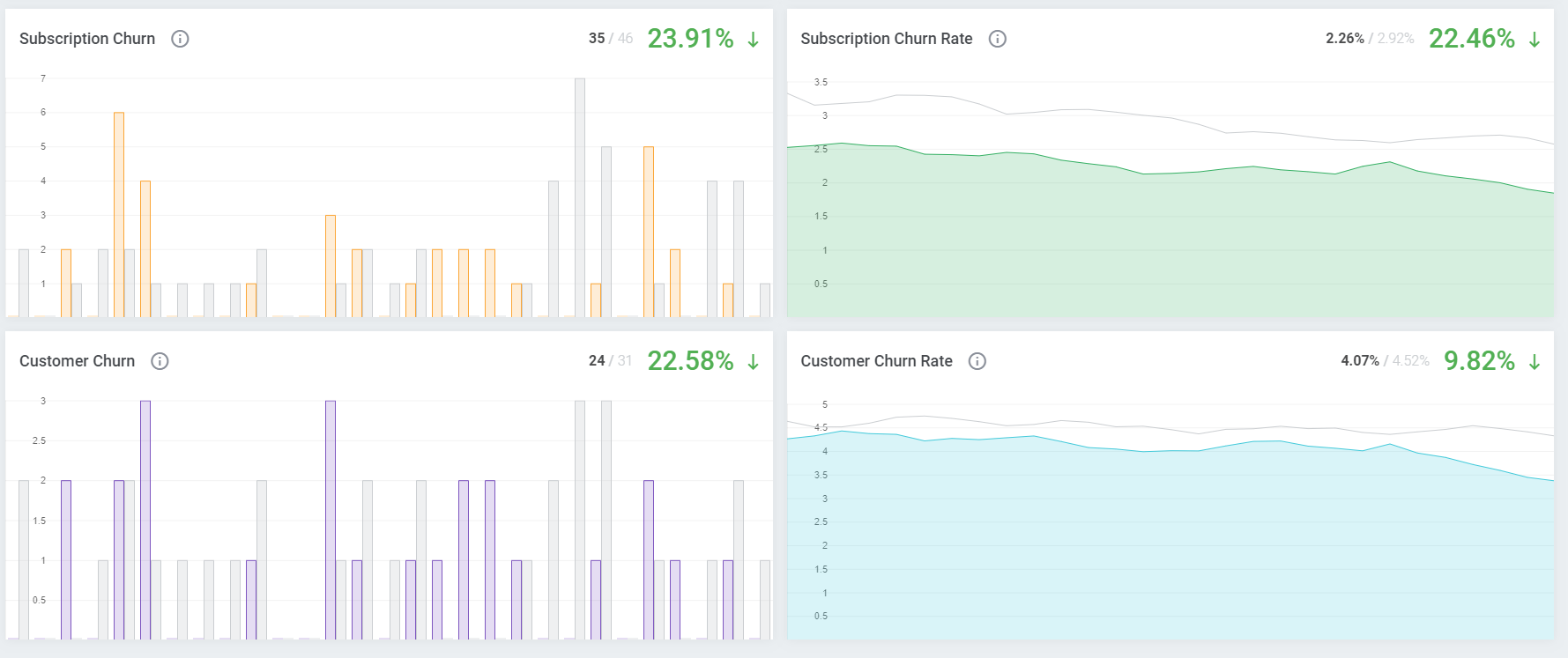Business owners go nuts whenever the word “Churn” is mentioned, but who can blame them when it basically means that something important has been lost. And who likes to lose anything? Okay, maybe a little weight, but definitely not a customer, revenue or a subscription. However, one thing to realize is that burying your head in the sand never makes the problem disappear. The sooner you face up to the problem, the better – but, you have to know your enemy well before you can effectively defeat it.

Churn vs churn rate
Surprisingly, the term “Churn rate” is actually more commonly used in everyday business life than „Churn” itself. What is the difference then?
Churn is the loss of a certain asset like a client, subscription or revenue.
Churn rate is the percentage of these losses within a given time period.
In MetricsCube, the churn rate is calculated for the last 30 days. For example:
- If you had a total of 100 customers, and 10 of them churned during the last 30 days, the churn rate would be 10%. In other words, the churn rate tells you that you’ve lost 10% of all the customers that you’ve had at the beginning of the period considered.
Churn types
You can find three different types of Churn reports in MetricsCube that you should definitely keep close tabs on:
- Revenue Churn – Shows the loss of revenue, or, more precisely, the loss of the Monthly Recurring Revenue. It directly affects the cashflow, and therefore is often considered to be the most important to monitor.
- Customer Churn – Presents the list of all customers that no longer have any active subscription in your system, either because they have cancelled it, or did not renew their last active subscription.
- Subscription Churn – Displays only the subscriptions (i.e. services, domains, addons) that have not been renewed. If most of your clients have one service per account, this report may be very similar to the Customer Churn.
 I’d recommend that you pay relatively closer attention to the Customer and Subscription Churn, rather than to the Revenue Churn. These two metrics let you better monitor the tendencies across your client base.
I’d recommend that you pay relatively closer attention to the Customer and Subscription Churn, rather than to the Revenue Churn. These two metrics let you better monitor the tendencies across your client base.
Is your churn rate high?
Churn rate level depends mainly on the business type and its degree of development, but there’s no clear indication if the revenue churn is high or low. Any business at an early stage may demonstrate a quite high level of this metric, but it eventually goes down as your market position settles. However, for a mature web hosting company, it is assumed that in order to keep the business sustainable, the churn rate shouldn’t be higher than 5%. So, if your company exceeds this standard, it’s about time you started looking deep for a real reason behind such a condition, and tried to implement effective solutions to improve it.
Reason behind the churn and how to counter it
It is very difficult to provide a universal reason for losing clients or revenue. Since no one knows your business as well as you do, you need to precisely observe the entire span of customer activity, and search for the critical points. First of all, you need to make sure that you have a solid reporting tool that gives you detailed information about the churn in your business. You must also remain flexible, react on time and try to understand your clients’ point of view. Exactly as in the meme: Improvise. Adapt. Overcome.
Below are the most common churn reasons with regard to a web hosting business:
- Competition – This is the absolute number one reason of churn in the competitive-driven industry like web hosting. Nowadays, it is quite easy to switch from one provider to another, so even a a few extra features or a subtle price difference in favor of your rivals may be a valid argument for your clients not to renew their current service.
How to counter:- Provide a unique selling point – Follow the example of such go-ahead providers as WPEngine who spotted a niche, and built they brand around a unique approach to the WordPress hosting. DigitalOcean built a robust panel that is easy to manage and focused on developers. Ask yourself an important question: what exactly can you offer to your customers that others don’t?
- Develop a close relationship with your customers – Big providers often make the mistake of gradually loosing meaningful contact with their audiences, as they become faceless firms that treat clients as numbers. If you can reach out to your customers directly, talk with them, provide a dedicated discount or service – do it! This way, they will never consider replacing you with a different vendor, even if your pricing is a bit higher.
- Falling behind with the offer – Is your offer attractive enough for your customers when compared to other providers? Make sure it is. Seems that your servers run more slowly than AWS? That’s not a good sign for sure. Your services must keep up with the offerings of top players on the market, or else your customers will not likely stay with you.
How to counter:- Adjust your offer – Make regular updates of your products, automatically upgrade the packages of your existing clients, or grant them discounts for their long-term loyalty. It’s a standard to provide more for less so you should not rebel against it.
- Improve your performance – Analyze the most popular companies and trace the level of their performance to make sure that you are not any worse. Perhaps the investment into a new hardware and replacement of the obsolete implements may pay off in a not-so-long term.
- Slow support – Not responding your clients within 15 minutes? You’re already below the industry standards. Fast support in as critical aspects as keeping a website or store online is always a priority for your customers so they expect every incident to be solved rapidly. If you can’t secure quality support services, they will get frustrated and look for alternatives.
How to counter:- Optimize your support services – Not every case calls for an instant reaction, just as not every problem needs to be addressed right away. Having limited resources requires you to adopt detailed prioritization of your undertakings. Make sure that you have a top-notch support tool in place, set up achievable goals, and monitor your team performance on a daily basis!
The list of churn reasons is much longer, as I could also touch upon troublesome payment processes, low client engagement, lack of post-sale procedures, global industry tendencies, or even just bad UX in your billing system. Whatever the reason is, however, you can never forget that churn must be systematically monitored, and you have to remain flexible when identifying and addressing issues to reduce it.
Let all those craving an even deeper knowledge on the subject feel invited to watch the below video guide packed with detailed insight:




